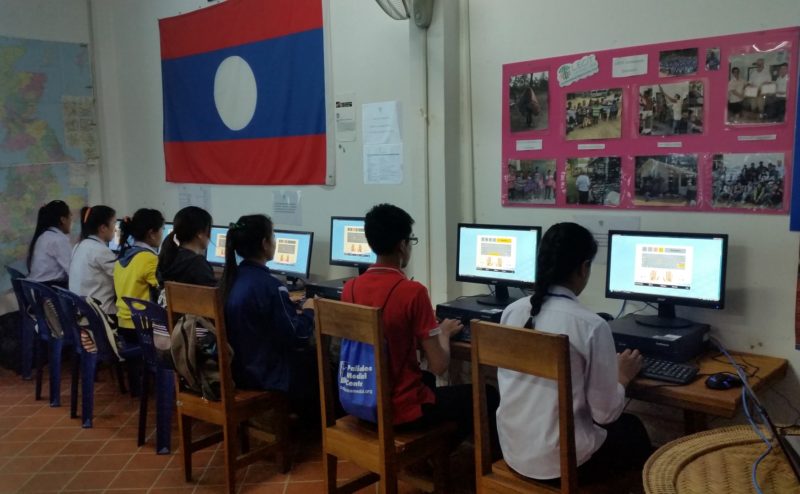
Skill gap hurdle as Laos attracts Southeast Asia’s spotlight
This article posted this week highlights the importance of Lao people getting the right education and opportunities for advancement – the very goal of my work in Laos.
Article taken from the Financial Express, 6 August 2016
The chance to tap into the promise of increasing prosperity and spending power among the 600 plus million population of South-East Asia brought ministers and international economic policymakers to meet in Vientiane, Laos this week.
To see the opportunities and challenges, one need not venture further than meeting host Laos.
Sometimes overlooked or misunderstood by outside observers, the diminutive Southeast nation was back in the spotlight this week as it rolled out the welcome mat for ministers responsible for economics, commerce and trade from the region and beyond meet this week in the capital Vientiane.
The country at the heart of the Mekong has been experiencing a prolonged moment in the spotlight as the rotating chair of the Association of Southeast Asian Nations (ASEAN) that sees it readying to welcome world leaders in September and follows the recent meeting of foreign ministers held in late July.
Along with regional and partner counterparts, the country’s policymakers have been keen to use the country’s year as ASEAN chair towards addressing the complex development needs of a young and expanding working age population that presents both promises of opportunity and extant challenges for economic policymaking and governance.
Famously, better transport and trade links to other members of its dynamic neighbourhood is helping to turn Laos once disadvantageous position as a relatively low population landlocked country into one increasingly “land-linked” and integrated with the much larger markets located across its borders and beyond.
Importantly, the country’s young population have fuelled expectations for a beneficial demographic dividend, provided the right education, health care and opportunities for advancement in what is increasingly a regionally and globally-focused economy.
This in turn is attracting the attention of investors and policymakers from abroad, seeking to utilise a rich bevvy of natural resources, a young and willing labour force while accessing an expanding market of household consumers increasingly ready to join regional peers in the achievement of greater material prosperity.
With this in mind, suitors from countries as far away as Canada, Russia, India, New Zealand and Australia were seen to join East Asian economic heavyweights China, Japan and South Korea in moving to solidify both economic, person-to-person and business-to-business links in countries such as Laos, seeking to tap into comparative advantages at home and unlock growth potential that makes the region a place of great economic promise.
Known well for its investments in hard infrastructure and its trading prowess, China’s investment in entrepreneurial networks is also significant, something expected to be on show during the hosting of the 8th ASEAN-China Young Entrepreneurs Forum in Malaysia which follows the successful 7th hosting in Vientiane in 2015.
Yet despite the opportunities increasingly on offer from the rapid rate of socio-economic change afoot across the region and a keenness to engage on all sides, significant gaps in educational attainment, skills and health indicators are among factors placing constraints on the number of people ready to tap into this progress.
Laos once again provides a case worthy of consideration. Economic growth from the mid six to seven per cent year on year has seen the country approaching its goal of achieving necessary metrics for graduation from the ranks of world’s least developed countries (LDCs) by 2020.
This is expected to be greatly helped by the nation’s favourable demographics, which will see it post the greatest percentage increase in the working age population in SE Asia in the next decade.
A diverse population with 49 ethnic groups and a majority of some 80 per cent dwelling in its rural and remote interior, literacy and educational attainment remain key human resource considerations in the country of some six and a half million.
Despite the strong growth and poverty reduction efforts, the pace of progress in some parts of the country has been slower than others.
An increasing middle class is clearly evident in the capital and other urban centres; this will need to be solidified by further progress in improved agricultural productivity and market access engaging those youths that can be witnessed dwelling by rural roadsides and in the valleys and mountain sides of the more remote areas.
Hard transport and infrastructure links and soft people-to-people links, education, financial capital and collateral access are all contributing to the kind of competence and confidence needed to continue the path out of poverty and towards prosperity for Laos alongside its larger neighbours and ASEAN peers.
Making the most of opportunities and spreading the benefits of the evolving economic landscape to more people is the great ongoing generational challenge facing policymakers and business leaders with a stake in the future, be it in Laos, the remainder of South-East Asia and beyond.
Comments RSS Feed